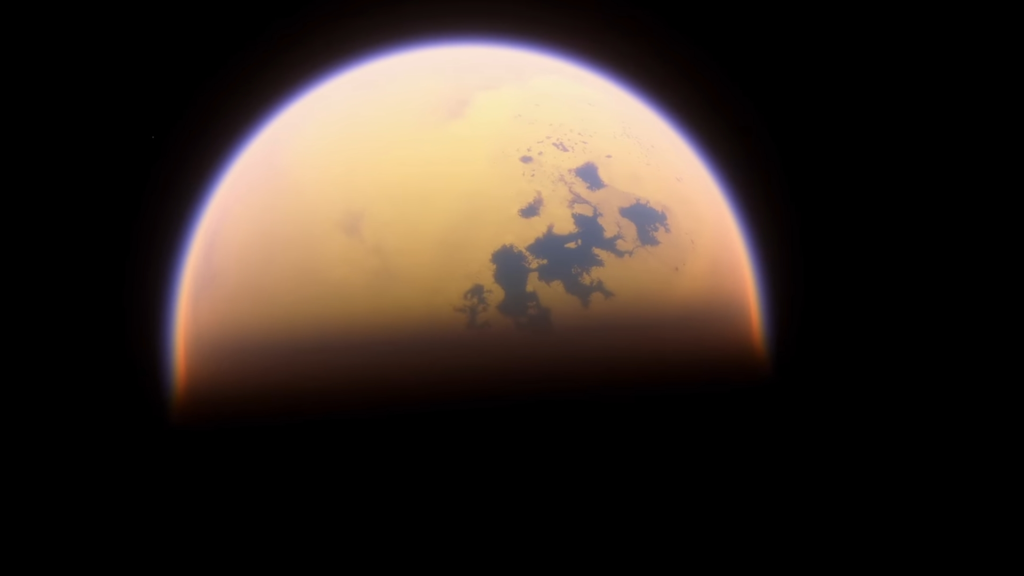
In the region of the gas giants, there lies a mysterious world which is shrouded in thick layers of haze. This is Titan, a moon larger than the planet Mercury and is orbiting the ringed world Saturn. It is a moon that has captivated the imaginations of scientists for decades. Because below all that thick cloud around the titan, vast seas, lakes and rivers have been discovered pouring over parts of its frozen surface.
Moon Titan is the only place in the solar system, other than Earth, where liquid flows across the surface. So just like here on Earth, could Titan’s seas and lakes harbour life? And if they do, what might it look like? Titan is a truly mysterious place. Although four separate spacecraft have flown by the moon, it still holds many secrets. Such as, where did its thick atmosphere come from? How did its lakes and seas form? And does it have the potential to harbour life?
Large bodies of liquid on Titan had been suspected since the Voyager probes passed by in the early 1980s, but it wasn’t until the Cassini spacecraft visited in 2006 that they were actually confirmed. Unlike the oceans of Earth, which are made up of water, it was discovered that the lakes and seas on Titan are made up of liquid methane and ethane.
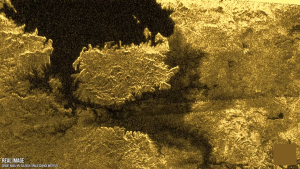
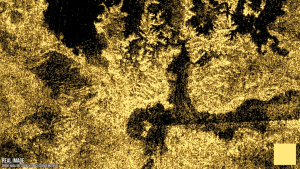
These lakes and seas, which can be seen in these dramatic radar images above, are typically located in the polar regions of Titan and they can be quite large. Some of the largest are comparable to the Great Lakes of North America for example.
Fed by rivers that cut through Titan’s frozen landscape, they are also incredibly deep, with some areas estimated to be over 200 metres or 656 feet deep. Although still a mystery, Titan’s seas and lakes are thought to have formed from the breakdown of methane and nitrogen in its atmosphere. Over time, these compounds condense into clouds and fall back to the surface as rain or possibly even snow.
On Earth, it is mainly the life itself that refreshes the methane supply in our atmosphere. Methane is usually a by-product of the metabolism of many life forms, and it comes from the simplest of biological sources, such as those associated with peat bogs, rice fields and animals like cows or sheep. So, could the methane on Titan be a sign of life?
One thing is for sure, if there is life on Titan, it won’t be like anything here on Earth. The lack of liquid water would mean that life as we know it, which relies on water, cannot exist on its surface. Here it is extremely cold, with temperatures hovering around -179 degrees Celsius or -290 degrees Fahrenheit. Making the conditions on this mysterious moon harsh and extremely challenging for living organisms as we know it.
But that doesn’t mean that life hasn’t found a way to thrive on Titan. Some microorganisms on Earth, for example, have been discovered to consume and survive in hydrocarbons, and the lakes on Titan are primarily composed of liquid methane and ethane, which are hydrocarbons.
Any life that could exist in these lakes would have to be adapted to living in an environment that is drastically different from Earth’s, but scientists have hypothesized that Titan’s life could be based on a completely different biochemistry.
Instead of relying on water as a solvent, these life forms could use hydrocarbons such as methane and ethane. This, however, would require a different cell structure for the organisms to survive. Drop any Earth organism into one of Titan’s lakes and it would not last long. Even our toughest single-celled beings are held together by membranes made from fatty molecules called lipids.
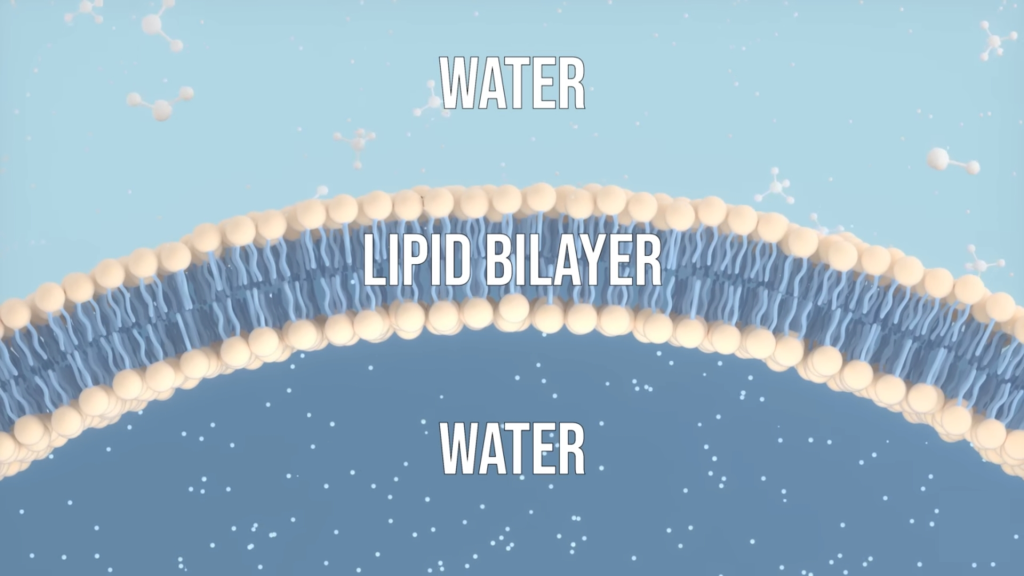
Lipids molecules hang together and form a barrier because certain parts attract water molecules while other parts repel them. But Titan’s lakes have no water to interact with, and the frigid temperatures would freeze any Earth life to solid. But another molecule like acrylonitrile might be able to do the same job and survive in Titan’s harsh conditions. It is incredible to say the least but scientists have found direct evidence of acrylonitrile molecules on Titan, and in sufficient quantities to theoretically support millions of single-celled life forms.
So it is possible that microorganisms could potentially form the basis of a complex ecosystem on this bizarre moon, possibly with a larger organism feeding on them and so on. However, as exciting as these ideas may be, at this point we don’t have enough information to know for sure what kind of life, if any, could exist on Titan.
The only probe ever to land on its surface was the Huygens probe, back in 2005, which entered Titan’s atmosphere and became the first probe to land on a moon in the outer solar system. It captured stunning images as it descended and landed, and continued to transmit data for about 90 minutes after landing.
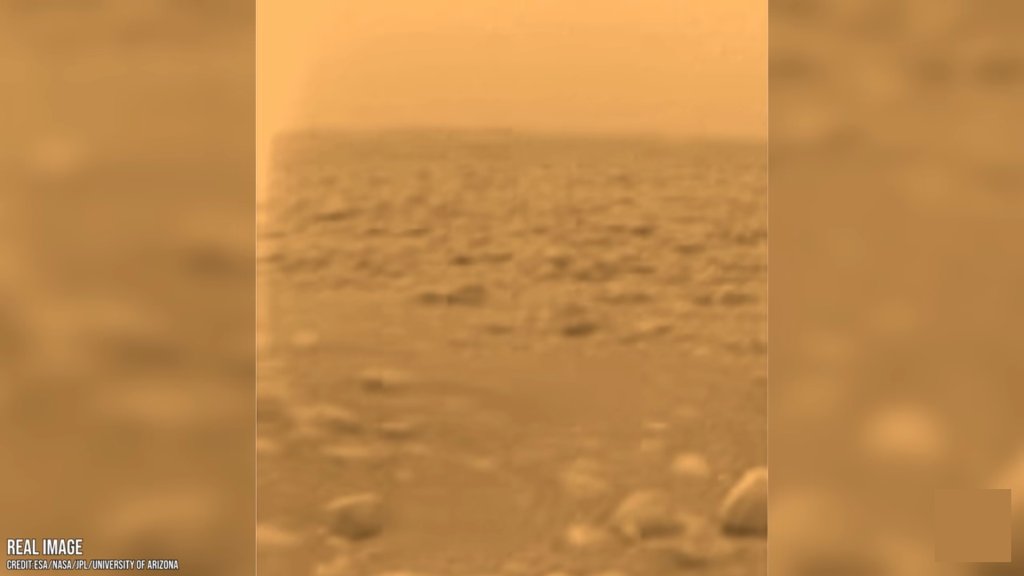
In the above incredible surface image, we can see what looks like a dried-up, relatively flat, peddle-strewn plain that may have once been covered in flowing liquid methane. But as you can see, there is no indication of life. Although the idea of strange life forms thriving across Titan’s surface is certainly an exciting one, the methane in its atmosphere is more likely to be the result of outgassing.
When Titan formed, it was probably too hot for volatile compounds like methane and nitrogen to remain on the surface. Instead, these compounds were trapped in the moon’s interior. Over time, the heat in Titan’s interior began to dissipate, causing the volatile compounds to escape through cracks in its crust. These compounds then combined to form the complex mixture of gases that make up Titan’s thick atmosphere we see today.
So if this is the reason for the abundant amounts of methane found in Titan’s atmosphere, and not the result of life swimming through its frigid, flowing lakes, then does that mean that this bizarre moon is sterile? Like most of the solar system, as far as we know, unable to harbour life. Well, possibly not.
Observations and measurements by the Cassini spacecraft and the Huygens probe suggest that Titan may have a subsurface ocean of liquid water, deep beneath the icy crust of the moon. If there is indeed a vast body of water below Titan’s crust, it is possible that life could exist within it.
Water is a key ingredient for life as we know it, and the ocean could provide a habitat for life forms adapted to the unique conditions of Titan’s environment. However, as with the methane lakes, the conditions in this subsurface ocean would be very different from those on Earth.
The ocean would be extremely cold and would likely contain a high concentration of salts and other dissolved substances, which could affect the ability of any potential life forms to survive. So Titan could potentially harbour environments with conditions suitable for life, meaning both life as we know it and life as we don’t know it.
Although so far, there is no evidence of life on Titan, it’s complex chemistry and unique environments are certain to make it a destination for continued exploration. One of the most exciting future missions is NASA’s Dragon Fly mission, which will send a rotorcraft lander to explore the surface of the shrouded moon.
Dragonfly is scheduled to launch in 2027, and it will arrive at Titan in 2034. The mission will be based on a rotorcraft lander, similar to the successful Ingenuity craft, which has completed more than 50 flights on Mars. Dragonfly will fly to multiple locations on the surface, including dunes, craters, and the equatorial region, where it will investigate the potential for liquid water and the chemical conditions that could support life.
As we continue to explore the outer reaches of our solar system, Titan remains a fascinating destination that holds the potential to revolutionize our understanding of the universe. With its methane lakes and seas, along with a secret subsurface ocean, this enigmatic moon is a world unlike any other. Will we one day discover life on this distant, hazy moon confirming that we are not alone? Only time will tell.


